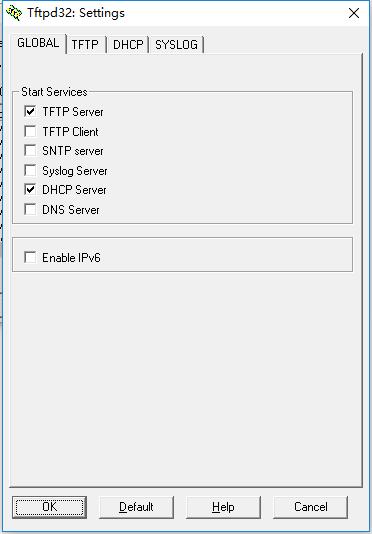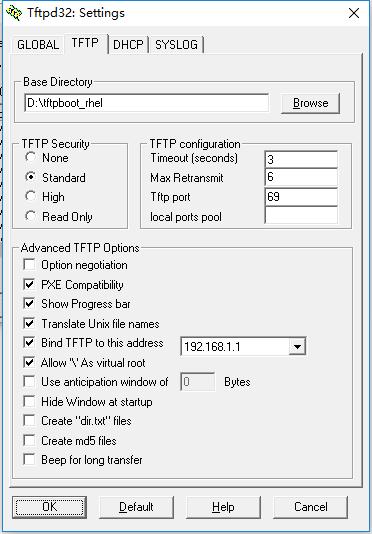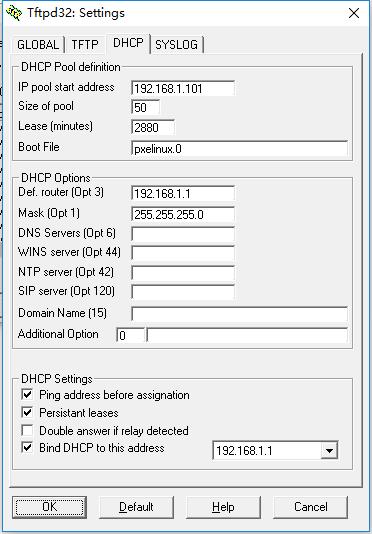前言
在tftp那篇文章中我提到過一般網(wǎng)絡(luò)安裝基于Linux下PXE+TFTP+DHCP+(HTTP/FTP/NFS)來實(shí)現(xiàn),然而在真實(shí)的生產(chǎn)環(huán)境中分別測(cè)試了Cloudboot和Cobbler率寡,面對(duì)大量型號(hào)和配置不一樣的物理機(jī)并不能滿足實(shí)際需求。最后采用Windows筆記本+交換機(jī)+tftpd32+kickstart來靈活應(yīng)對(duì)esxi6和rhel6.7的自動(dòng)化裝機(jī)艰山,為了不依賴自動(dòng)化光盤安裝的低效懶人模式,中間還是踩了不少的坑结蟋。個(gè)人覺得裝機(jī)并沒有孰優(yōu)孰劣的說法妥粟,而且未來是屬于分布式存儲(chǔ)+萬兆交換機(jī)+類似VMware/OpenStack的模式,人肉裝機(jī)的時(shí)代已經(jīng)離我們漸行漸遠(yuǎn)窝趣。
利用tftpd32快速搭建自動(dòng)化網(wǎng)絡(luò)搞機(jī)平臺(tái)
更新歷史
2017年01月19日 - 初稿
閱讀原文 - https://wsgzao.github.io/post/tftpd32/
擴(kuò)展閱讀
Tftd32 - http://tftpd32.jounin.net/
Kickstart Generator - https://access.redhat.com/labsinfo/kickstartconfig
3點(diǎn)建議
- PXE只是網(wǎng)絡(luò)安裝的引導(dǎo)方式,自動(dòng)化的核心配置文件始終依賴kickstart/autoyast/autounattend等
- 文章內(nèi)提到的引導(dǎo)介質(zhì)均提取自rhel6.7鏡像文件
syslinux-nonlinux-4.04-3.el6.noarch.rpm - 云霽科技的Cloudboot成熟度非常高训柴,建議大家多參考其高質(zhì)量的配置方案
CloudBoot 云啟裝機(jī)平臺(tái)(開源版) - http://www.idcos.com/products/cloudboot-open-source



esxi
tftpd32+esxi6.0u2+kickstart+hfs
- Windows下關(guān)閉防火墻哑舒,設(shè)置IP地址為192.168.1.1/24
- 啟動(dòng)tftpd32參考上圖所示配置,
Base Directory目錄選擇實(shí)際定義的路徑幻馁,如tftpboot_esxi\ - 解壓ESXi ISO至
tftpboot_esxi\洗鸵,修改BOOT.CFG添加kernelopt=ks=http://192.168.1.1/esxi6/KS.CFG - 將KS.CFG放入自定義目錄越锈,使用hfs加載
- 復(fù)制syslinux中的pxelinux.0到
tftpboot_esxi\ - 復(fù)制syslinux中的MENU.C32
替換tftpboot_esxi`中的同名文件 - 創(chuàng)建
tftpboot_esxi\pxelinux.cfg\目錄,復(fù)制ESXi ISO文件中的ISOLINUX.CFG至該目錄并改名為default - 檢查tftpd32服務(wù)啟動(dòng)正常膘滨,測(cè)試自動(dòng)化網(wǎng)絡(luò)安裝esxi
#BOOT.CFG
bootstate=0
title=Loading ESXi installer
timeout=5
kernel=/tboot.b00
kernelopt=ks=http://192.168.1.1/esxi6/KS.CFG
modules=/b.b00 --- /jumpstrt.gz --- /useropts.gz --- /k.b00 --- /chardevs.b00 --- /a.b00 --- /user.b00 --- /uc_intel.b00 --- /uc_amd.b00 --- /sb.v00 --- /s.v00 --- /scsi_mpt.v00 --- /net_tg3.v00 --- /elxnet.v00 --- /ima_be2i.v00 --- /lpfc.v00 --- /scsi_be2.v00 --- /amsHelpe.v00 --- /conrep.v00 --- /hpbootcf.v00 --- /hpe_buil.v00 --- /hpe_esxi.v00 --- /hpe_ilo.v00 --- /hpe_smx_.v00 --- /hponcfg.v00 --- /hpssacli.v00 --- /hptestev.v00 --- /char_hpc.v00 --- /hpnmi.v00 --- /scsi_hpd.v00 --- /scsi_hps.v00 --- /scsi_hpv.v00 --- /intelcim.v00 --- /net_i40e.v00 --- /net_igb.v00 --- /net_ixgb.v00 --- /nmlx4_co.v00 --- /nmlx4_en.v00 --- /misc_cni.v00 --- /net_bnx2.v00 --- /net_bnx2.v01 --- /net_cnic.v00 --- /net_nx_n.v00 --- /net_qlcn.v00 --- /qlnative.v00 --- /scsi_bfa.v00 --- /scsi_bnx.v00 --- /scsi_bnx.v01 --- /scsi_qla.v00 --- /mtip32xx.v00 --- /ata_pata.v00 --- /ata_pata.v01 --- /ata_pata.v02 --- /ata_pata.v03 --- /ata_pata.v04 --- /ata_pata.v05 --- /ata_pata.v06 --- /ata_pata.v07 --- /block_cc.v00 --- /ehci_ehc.v00 --- /emulex_e.v00 --- /weaselin.t00 --- /esx_dvfi.v00 --- /esx_ui.v00 --- /ima_qla4.v00 --- /ipmi_ipm.v00 --- /ipmi_ipm.v01 --- /ipmi_ipm.v02 --- /lsi_mr3.v00 --- /lsi_msgp.v00 --- /lsu_hp_h.v00 --- /lsu_lsi_.v00 --- /lsu_lsi_.v01 --- /lsu_lsi_.v02 --- /lsu_lsi_.v03 --- /lsu_lsi_.v04 --- /misc_dri.v00 --- /net_e100.v00 --- /net_e100.v01 --- /net_enic.v00 --- /net_forc.v00 --- /net_mlx4.v00 --- /net_mlx4.v01 --- /net_vmxn.v00 --- /nmlx4_rd.v00 --- /nvme.v00 --- /ohci_usb.v00 --- /rste.v00 --- /sata_ahc.v00 --- /sata_ata.v00 --- /sata_sat.v00 --- /sata_sat.v01 --- /sata_sat.v02 --- /sata_sat.v03 --- /sata_sat.v04 --- /scsi_aac.v00 --- /scsi_adp.v00 --- /scsi_aic.v00 --- /scsi_fni.v00 --- /scsi_ips.v00 --- /scsi_meg.v00 --- /scsi_meg.v01 --- /scsi_meg.v02 --- /scsi_mpt.v01 --- /scsi_mpt.v02 --- /uhci_usb.v00 --- /vsan.v00 --- /vsanheal.v00 --- /vsanmgmt.v00 --- /xhci_xhc.v00 --- /tools.t00 --- /nmst.v00 --- /xorg.v00 --- /imgdb.tgz --- /imgpayld.tgz
build=
updated=0
#default
DEFAULT menu.c32
MENU TITLE ESXi6.0u2 Boot Menu
NOHALT 1
PROMPT 0
TIMEOUT 80
LABEL install
KERNEL mboot.c32
APPEND -c boot.cfg
MENU LABEL ESXi6.0u2 ^Installer
LABEL hddboot
LOCALBOOT 0x80
MENU LABEL ^Boot from local disk
#KS.CFG
# Accept the VMware End User License Agreement
vmaccepteula
# Set the root password for the DCUI and Tech Support Mode
rootpw admin123
# Install on the first local disk available on machine
install --firstdisk --overwritevmfs
# Set the network to DHCP on the first network adapter
network --bootproto=dhcp --device=vmnic0
# Reboot at the end
reboot
file://H:\01_autoinstall\tftpboot_esxi (3 folders, 129 files, 377.76 MB, 379.93 MB in total.)
│ .DISCINFO 33 bytes
│ A.B00 10.96 KB
│ AMSHELPE.V00 1.32 MB
│ ATA_PATA.V00 8.28 KB
│ ATA_PATA.V01 6.22 KB
│ ATA_PATA.V02 6.47 KB
│ ATA_PATA.V03 7.22 KB
│ ATA_PATA.V04 8.33 KB
│ ATA_PATA.V05 7.01 KB
│ ATA_PATA.V06 6.17 KB
│ ATA_PATA.V07 7.59 KB
│ B.B00 75.03 KB
│ BLOCK_CC.V00 23.75 KB
│ BOOT.CAT 512 bytes
│ BOOT.CFG 2.07 KB
│ CHAR_HPC.V00 9.93 KB
│ CHARDEVS.B00 18.67 KB
│ CONREP.V00 1.87 MB
│ EFIBOOT.IMG 1.00 MB
│ EHCI_EHC.V00 32.99 KB
│ ELXNET.V00 132.88 KB
│ EMULEX_E.V00 5.68 KB
│ ESX_DVFI.V00 89.19 KB
│ ESX_UI.V00 2.83 MB
│ HPBOOTCF.V00 28.52 KB
│ HPE_BUIL.V00 458 bytes
│ HPE_ESXI.V00 1.51 MB
│ HPE_ILO.V00 9.50 KB
│ HPE_SMX_.V00 7.81 MB
│ HPNMI.V00 4.20 KB
│ HPONCFG.V00 96.62 KB
│ HPSSACLI.V00 4.97 MB
│ HPTESTEV.V00 6.29 KB
│ IMA_BE2I.V00 489.49 KB
│ IMA_QLA4.V00 359.39 KB
│ IMGDB.TGZ 62.35 KB
│ IMGPAYLD.TGZ 3.94 MB
│ INTELCIM.V00 94.06 KB
│ IPMI_IPM.V00 9.38 KB
│ IPMI_IPM.V01 22.99 KB
│ IPMI_IPM.V02 27.91 KB
│ ISOLINUX.BIN 14.00 KB
│ ISOLINUX.CFG 231 bytes
│ JUMPSTRT.GZ 20 bytes
│ K.B00 3.26 MB
│ KS.CFG 356 bytes
│ LPFC.V00 555.77 KB
│ LSI_MR3.V00 68.98 KB
│ LSI_MSGP.V00 117.96 KB
│ LSU_HP_H.V00 15.34 KB
│ LSU_LSI_.V00 78.96 KB
│ LSU_LSI_.V01 159.84 KB
│ LSU_LSI_.V02 78.96 KB
│ LSU_LSI_.V03 187.32 KB
│ LSU_LSI_.V04 114.35 KB
│ MBOOT.C32 84.17 KB
│ MENU.C32 60.35 KB
│ MISC_CNI.V00 5.51 KB
│ MISC_DRI.V00 1.24 MB
│ MTIP32XX.V00 67.84 KB
│ NET_BNX2.V00 178.17 KB
│ NET_BNX2.V01 1.00 MB
│ NET_CNIC.V00 48.42 KB
│ NET_E100.V00 93.66 KB
│ NET_E100.V01 108.27 KB
│ NET_ENIC.V00 43.63 KB
│ NET_FORC.V00 36.61 KB
│ NET_I40E.V00 132.01 KB
│ NET_IGB.V00 101.62 KB
│ NET_IXGB.V00 167.56 KB
│ NET_MLX4.V00 107.78 KB
│ NET_MLX4.V01 66.30 KB
│ NET_NX_N.V00 1.32 MB
│ NET_QLCN.V00 283.02 KB
│ NET_TG3.V00 107.81 KB
│ NET_VMXN.V00 30.50 KB
│ NMLX4_CO.V00 117.53 KB
│ NMLX4_EN.V00 119.73 KB
│ NMLX4_RD.V00 39.92 KB
│ NMST.V00 12.32 KB
│ NVME.V00 63.07 KB
│ OHCI_USB.V00 19.44 KB
│ pxelinux.0 26.13 KB
│ QLNATIVE.V00 731.51 KB
│ RSTE.V00 209.06 KB
│ S.V00 92.98 MB
│ SAFEBOOT.C32 61.79 KB
│ SATA_AHC.V00 19.80 KB
│ SATA_ATA.V00 11.79 KB
│ SATA_SAT.V00 17.16 KB
│ SATA_SAT.V01 10.32 KB
│ SATA_SAT.V02 10.86 KB
│ SATA_SAT.V03 8.03 KB
│ SATA_SAT.V04 6.35 KB
│ SB.V00 48.31 MB
│ SCSI_AAC.V00 52.10 KB
│ SCSI_ADP.V00 143.31 KB
│ SCSI_AIC.V00 95.67 KB
│ SCSI_BE2.V00 247.25 KB
│ SCSI_BFA.V00 1.20 MB
│ SCSI_BNX.V00 95.69 KB
│ SCSI_BNX.V01 78.25 KB
│ SCSI_FNI.V00 64.13 KB
│ SCSI_HPD.V00 937.40 KB
│ SCSI_HPS.V00 72.92 KB
│ SCSI_HPV.V00 704.64 KB
│ SCSI_IPS.V00 32.12 KB
│ SCSI_MEG.V00 28.29 KB
│ SCSI_MEG.V01 54.13 KB
│ SCSI_MEG.V02 26.45 KB
│ SCSI_MPT.V00 132.34 KB
│ SCSI_MPT.V01 147.33 KB
│ SCSI_MPT.V02 124.50 KB
│ SCSI_QLA.V00 147.12 KB
│ TBOOT.B00 43.32 KB
│ TOOLS.T00 180.67 MB
│ UC_AMD.B00 3.41 KB
│ UC_INTEL.B00 135.83 KB
│ UHCI_USB.V00 19.82 KB
│ USER.B00 447.52 KB
│ USEROPTS.GZ 20 bytes
│ VMWARE-ESX-BASE-OSL.TXT 1.13 MB
│ VMWARE-ESX-BASE-README 2.19 KB
│ VSAN.V00 6.73 MB
│ VSANHEAL.V00 168.57 KB
│ VSANMGMT.V00 1.35 MB
│ WEASELIN.T00 1.93 MB
│ XHCI_XHC.V00 72.94 KB
│ XORG.V00 1.28 MB
├─EFI (1 folders, 0 files, 0 bytes, 193.17 KB in total.)
│ └─BOOT (0 folders, 3 files, 193.17 KB, 193.17 KB in total.)
│ BOOT.CFG 2.04 KB
│ BOOTIA32.EFI 94.59 KB
│ BOOTX64.EFI 96.53 KB
├─pxelinux.cfg (0 folders, 1 files, 231 bytes, 231 bytes in total.)
│ default 231 bytes
└─UPGRADE (0 folders, 10 files, 1.98 MB, 1.98 MB in total.)
ESXIMAGE.ZIP 874.17 KB
EXTLINUX 62.51 KB
ISOINFO 233.62 KB
MBR.BIN 440 bytes
MCOPY 584.17 KB
METADATA.XML 1.54 KB
METADATA.ZIP 141.08 KB
PRECHECK.PY 72.78 KB
PREP.PY 47.54 KB
PROFILE.XML 8.85 KB
引用他人在Linux下的安裝流程
PEX安裝ESXi6 - http://blog.csdn.net/onlyshenmin/article/details/52434743
#安裝dhcp甘凭、tftp-server、syslinux火邓、xinetd丹弱。
yum install dhcp tftp-server syslinux xinetd
#掛載ESXi ISO到/mnt
mount /dev/cdrom /mnt
#修改dhcpd.conf
ddns-update-style interim;
allow booting;
allow bootp;
class "pxeclients" {
match if substring(option vendor-class-identifier, 0, 9) = "PXEClient";
next-server 172.16.8.7;
filename = "pxelinux.0";
}
subnet 172.16.8.0 netmask 255.255.255.0 {
range 172.16.8.100 172.16.8.199;
}
#啟用tftp,修改/etc/xinetd.d/tftp中的disable = yes為disable = no
service tftp
{
socket_type = dgram
protocol = udp
wait = yes
user = root
server = /usr/sbin/in.tftpd
server_args = -s /var/lib/tftpboot
disable = no
per_source = 11
cps = 100 2
flags = IPv4
}
#復(fù)制pxelinux.0到tftp根目錄
cp /usr/share/syslinux/pxelinux.0 /var/lib/tftpboot/
#新建目錄/var/lib/tftpboot/pxelinux.cfg
mkdir /var/lib/tftpboot/pxelinux.cfg
#復(fù)制ESXi ISO文件中的isolinux.cfg到/var/lib/tftpboot/pxelinux.cfg/下并改名default
cp /mnt/isolinux.cfg /var/lib/tftpboot/pxelinux.cfg/default
#復(fù)制ESXi ISO中的全部文件到/var/lib/tftpboot/下
cp -a /mnt/* /var/lib/tftpboot/
#復(fù)制syslinux自帶的menu.c32到tftp根目錄替換掉ESXI ISO里的menu.c32。
cp /usr/share/syslinux/menu.c32 /var/lib/tftpboot/
#重啟dhcp铲咨、xinetd服務(wù)
systemctl restart dhcpd
systemctl restart xinetd
#自定義安裝腳本躲胳,安裝httpd,編輯腳本ks.cfg
vim /var/www/html/ks.cfg
#
# Sample scripted installation file
#
# Accept the VMware End User License Agreement
vmaccepteula
# Set the root password for the DCUI and Tech Support Mode
rootpw mypassword
# Install on the first local disk available on machine
install --firstdisk --overwritevmfs
# Set the network to DHCP on the first network adapter
network --bootproto=dhcp --device=vmnic0
# A sample post-install script
%post --interpreter=python --ignorefailure=true
import time
stampFile = open('/finished.stamp', mode='w')
stampFile.write( time.asctime() )
#編輯ESXi ISO復(fù)制過來的boot.cfg文件纤勒,添加kernelopt=ks=http://172.16.8.7/ks.cfg
vim /var/lib/tftpboot/boot.cfg
bootstate=0
title=Loading ESXi installer
timeout=5
kernel=/tboot.b00
kernelopt=ks=http://172.16.8.7/ks.cfg
modules=/b.b00 --- /jumpstrt.gz --- /useropts.gz --- /k.b00 --- /chardevs.b00 --- /a.b00 --- /user.b00 --- /uc_intel.b00 --- /uc_amd.b00 --- /sb.v00 --- /s.v00 --- /mtip32xx.v00 --- /ata_pata.v00 --- /ata_pata.v01 --- /ata_pata.v02 --- /ata_pata.v03 --- /ata_pata.v04 --- /ata_pata.v05 --- /ata_pata.v06 --- /ata_pata.v07 --- /block_cc.v00 --- /ehci_ehc.v00 --- /elxnet.v00 --- /emulex_e.v00 --- /weaselin.t00 --- /esx_dvfi.v00 --- /esx_ui.v00 --- /ima_qla4.v00 --- /ipmi_ipm.v00 --- /ipmi_ipm.v01 --- /ipmi_ipm.v02 --- /lpfc.v00 --- /lsi_mr3.v00 --- /lsi_msgp.v00 --- /lsu_hp_h.v00 --- /lsu_lsi_.v00 --- /lsu_lsi_.v01 --- /lsu_lsi_.v02 --- /lsu_lsi_.v03 --- /lsu_lsi_.v04 --- /misc_cni.v00 --- /misc_dri.v00 --- /net_bnx2.v00 --- /net_bnx2.v01 --- /net_cnic.v00 --- /net_e100.v00 --- /net_e100.v01 --- /net_enic.v00 --- /net_forc.v00 --- /net_igb.v00 --- /net_ixgb.v00 --- /net_mlx4.v00 --- /net_mlx4.v01 --- /net_nx_n.v00 --- /net_tg3.v00 --- /net_vmxn.v00 --- /nmlx4_co.v00 --- /nmlx4_en.v00 --- /nmlx4_rd.v00 --- /nvme.v00 --- /ohci_usb.v00 --- /qlnative.v00 --- /rste.v00 --- /sata_ahc.v00 --- /sata_ata.v00 --- /sata_sat.v00 --- /sata_sat.v01 --- /sata_sat.v02 --- /sata_sat.v03 --- /sata_sat.v04 --- /scsi_aac.v00 --- /scsi_adp.v00 --- /scsi_aic.v00 --- /scsi_bnx.v00 --- /scsi_bnx.v01 --- /scsi_fni.v00 --- /scsi_hps.v00 --- /scsi_ips.v00 --- /scsi_meg.v00 --- /scsi_meg.v01 --- /scsi_meg.v02 --- /scsi_mpt.v00 --- /scsi_mpt.v01 --- /scsi_mpt.v02 --- /scsi_qla.v00 --- /uhci_usb.v00 --- /vsan.v00 --- /vsanheal.v00 --- /vsanmgmt.v00 --- /xhci_xhc.v00 --- /tools.t00 --- /xorg.v00 --- /imgdb.tgz --- /imgpayld.tgz
build=
updated=0
rhel
tftpd32+rhel6.7+kickstart+hfs
- Windows下關(guān)閉防火墻坯苹,設(shè)置IP地址為192.168.1.1/24
- 啟動(dòng)tftpd32參考上圖所示配置,
Base Directory目錄選擇實(shí)際定義的路徑摇天,如tftpboot_rhel\ - 解壓rhel6.7 ISO至自定義目錄粹湃,使用hfs作為http文件服務(wù)器
- 將ks.cfg放入自定義目錄,使用hfs加載
- 復(fù)制syslinux中的
pxelinux.0/initrd.img/vesamenu.c32/vmlinuz到tftpboot_rhel\ - 創(chuàng)建pxelinux.cfg目錄泉坐,復(fù)制rhel6.7 ISO文件中的ISOLINUX.CFG至該目錄并改名為default
- 修改default文件为鳄,ks=http://192.168.1.1/rhel67/ks.cfg ksdevice=eth10,出現(xiàn)
multiple network devices提示一定要加入ksdevice確認(rèn)網(wǎng)卡 - 檢查tftpd32服務(wù)啟動(dòng)正常坚冀,測(cè)試自動(dòng)化網(wǎng)絡(luò)安裝rhel
#default
default vesamenu.c32
#prompt 1
timeout 60
display boot.msg
menu background splash.jpg
menu title Welcome to Red Hat Enterprise Linux 6.7!
menu color border 0 #ffffffff #00000000
menu color sel 7 #ffffffff #ff000000
menu color title 0 #ffffffff #00000000
menu color tabmsg 0 #ffffffff #00000000
menu color unsel 0 #ffffffff #00000000
menu color hotsel 0 #ff000000 #ffffffff
menu color hotkey 7 #ffffffff #ff000000
menu color scrollbar 0 #ffffffff #00000000
label linux
menu label ^Install or upgrade an existing system
menu default
kernel vmlinuz
append initrd=initrd.img ks=http://192.168.1.1/rhel67/ks.cfg ksdevice=eth10
label vesa
menu label Install system with ^basic video driver
kernel vmlinuz
append initrd=initrd.img nomodeset
label rescue
menu label ^Rescue installed system
kernel vmlinuz
append initrd=initrd.img rescue
label local
menu label Boot from ^local drive
localboot 0xffff
label memtest86
menu label ^Memory test
kernel memtest
append -
#ks.cfg
#platform=x86, AMD64, or Intel EM64T
#version=DEVEL
# Firewall configuration
firewall --disabled
# Install OS instead of upgrade
install
#cdrom
url --url=http://192.168.1.1/rhel67/
# Network
#network --bootproto=dhcp --device=eth0
# Root password
rootpw admin123
# System authorization information
auth --useshadow --passalgo=sha512
# Use text mode install
text
firstboot --disable
# System keyboard
keyboard us
# System language
lang en_US.UTF-8
# SELinux configuration
selinux --disabled
# Installation logging level
logging --level=info
# Reboot after installation
reboot
# System timezone
timezone Asia/Shanghai
# System bootloader configuration
bootloader --location=mbr --append="rhgb quiet crashkernel=auto"
# Clear the Master Boot Record
zerombr
# Partition clearing information
clearpart --all --initlabel
# Partition
#autopart
part /boot --fstype=ext4 --size=500
part pv.008002 --grow --size=1
volgroup VolGroup --pesize=4096 pv.008002
logvol / --fstype=ext4 --name=lv_root --vgname=VolGroup --size=20480
logvol /home --fstype=ext4 --name=lv_home --vgname=VolGroup --size=20480
logvol /opt --fstype=ext4 --name=lv_opt --vgname=VolGroup --size=20480
logvol /tmp --fstype=ext4 --name=lv_tmp --vgname=VolGroup --size=20480
logvol /usr --fstype=ext4 --name=lv_usr --vgname=VolGroup --size=20480
logvol /var --fstype=ext4 --name=lv_var --vgname=VolGroup --size=20480
logvol swap --name=lv_swap --vgname=VolGroup --size=65536
# Packages
%packages
@base
@chinese-support
@client-mgmt-tools
@core
@debugging
@basic-desktop
@desktop-debugging
@desktop-platform
@directory-client
@fonts
@general-desktop
@graphical-admin-tools
@input-methods
@internet-browser
@java-platform
@legacy-x
@network-file-system-client
@perl-runtime
@print-client
@remote-desktop-clients
@server-platform
@server-policy
@x11
pax
python-dmidecode
oddjob
wodim
sgpio
genisoimage
mtools
abrt-gui
certmonger
pam_krb5
krb5-workstation
libXmu
perl-DBD-SQLite
%end
file://H:\01_autoinstall\tftpboot_rhel (1 folders, 4 files, 38.93 MB, 38.93 MB in total.)
│ initrd.img 34.72 MB
│ pxelinux.0 26.13 KB
│ vesamenu.c32 159.89 KB
│ vmlinuz 4.03 MB
└─pxelinux.cfg (0 folders, 1 files, 991 bytes, 991 bytes in total.)
default 991 bytes
引用他人在Linux下的安裝流程
RHEL6 (64bits)系統(tǒng)上利用PXE+DHCP+TFTP+KickStart批量安裝系統(tǒng)
http://chrinux.blog.51cto.com/6466723/1214641
CentOS 6.4下PXE+Kickstart無人值守安裝操作系統(tǒng)
http://www.cnblogs.com/mchina/p/centos-pxe-kickstart-auto-install-os.html
tftpd32
請(qǐng)?jiān)试S我直接偷懶引用官方簡(jiǎn)潔純樸的英文說明济赎,希望大家在遇到問題前回顧下每個(gè)選項(xiàng)的解釋,謝謝
Tftpd32 is a free, opensource IPv6 ready application which includes DHCP, TFTP, DNS, SNTP and Syslog servers as well as a TFTP client.
TFTP
Trivial File Transfer Protocol was first defined in 1980, it is a lightweight version of the FTP protocol that has no directory browsing or password capability. Employing UDP rather than TCP for transport, TFTP is typically used to transfer firmware upgrades to network equipment such as routers, switches and IP phones.It is also used to boot diskless computers (PXE).
SNTP
Simple Network Timle Protocol is a simplified version of NTP (Network Time Protocol). They synchronise the time on workstations across a network.
DHCP
DHCP assigns IP addresses to client stations logging onto a TCP/IP network. It eliminates having to manually assign permanent IP addresses on each station.
Syslog
Syslog is a service for remotely logging data. For example, it allows to monitor videoless network equipments.
Tftpd server Settings
Base directory
The default directory used by the TFTP client and server. It may be changed from the main window.
Global Settings
Enable or disable tftpd32 servers and clients.
TFTP security
- NONE (Not recommended !)
read and write requests are allowed on all disks/directories. - Standard
read and write requests are allowed but limited to the current directory. - High
idem standard + write requests are allowed only if the input file exists and is empty. - Read only
idem standard + write requests are rejected.
TFTP Configuration
- Timeout
The maximum timeout between two retransmissions - Max Retransmit
The maximum retransmission for the same packet - Tftp Port
The port used to listen incoming requests - local ports pool
A range of ports (for example 3000:3030). These ports are used for the file transfers.
TFTP Configuration
- Option Negotiation
Enables the negotiation between client and server (RFC 2347) - PXE compatibility
Enables only the file size negotiation - Show progress Bar
Creates a gauge window for each transfer - Translate Unix file names
Translates any slash characters to a backslash - Bind Tftpd32 to this address
Enables TFTP only on one interface - Allow '' As virtual root
A file name beginning with '' points to the TFTP directory and not to the root of the disk - Use anticipation window of ??? bytes
Tftpd32 is able to send packets before receiving acknowledgements. This feature may dramatically speed up the transfer. - Hide window at startup
Tftpd32 main window remains hidden, but the icon in the tasktray is still present - Create dir.txt files
For each incoming read request, Tftpd32 lists the content of the directory and put the result in a file named "dir.txt". - Create md5 file
For each successfull read request, Tftpd32 creates a file which is the MD5 signature of the previous file
Beep for long transfer
Tftpd32 sends a beep once a transfer has ended.
DHCP Setup
- IP Pool starting Address
This is the first address which will be distributed. - Size of pool
This is the number of hosts which may be configured by Tftpd32. - Lease
This is the amount of time in minutes the address is leased for. - Boot File
Used by diskless stations. It is the file which will be retrieved by TFTP to start up the boot process.
The strings $MAC$ and $IP$ are pseudo variables which are translated into the MAC address of the client and its assignated IP address. - Default router
The IP address of the LAN gateway. - Mask
The network mask which will be assigned to the DHCP clients. - DNS servers
The IP address of the DNS. Two DNS can be configured. - WINS Server
The IP address of the WINS server. - NTP Server
The IP address of the NTP server used for synchronisation. - SIP Server
The IP address of the SIP server. It concerns mostly IP phones. - Domain Name
Either the NT domain or the internet domain. - Additional Option
The first field is the number of the option to be handled
The second filed is the value of the field. The value is prefixed with its type (a for list of IPv4 address, x for list of hex digits, b for list of decimal bytes, s for an ASCII string) [legacy prefixes: i for integer, n for network order integers] - More Additional Options ?
Tftpd32 supports up to 10 additionnal options. They have to be configured by editing the tftpd32.ini settings file. Their syntax is similar to the previous one.